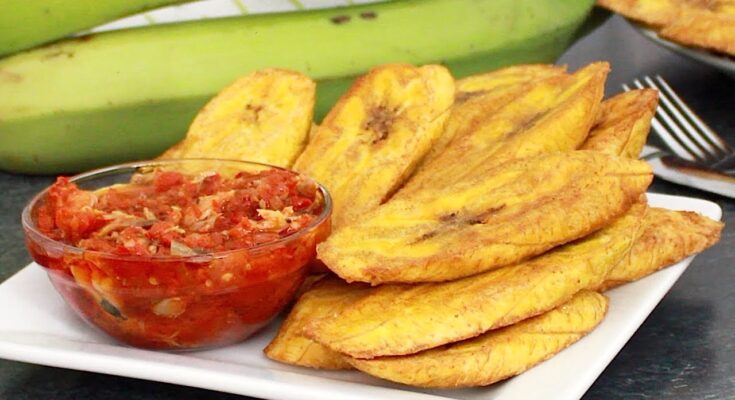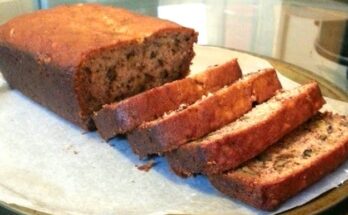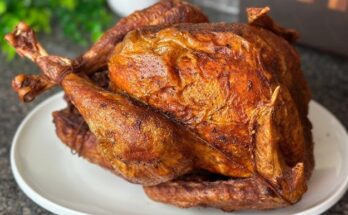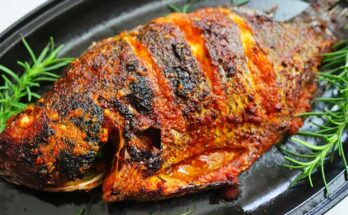Fried Plantain Recipe: Fried plantains are a simple, delicious dish made by slicing ripe plantains and frying them until they turn golden brown and caramelized. Plantains are similar to bananas but larger, starchier, and less sweet when unripe. They’re a staple in many cuisines around the world, especially in Africa, the Caribbean, and Latin America. While the concept is straightforward—just fry some slices in oil—the result is pure magic: crispy edges, soft centers, and a naturally sweet flavor that intensifies with heat.
Whether you enjoy them as a snack, a side dish, or even a dessert, fried plantains are one of those comfort foods that never fail to hit the spot. They’re also incredibly versatile—you can fry them when they’re yellow and sweet, or green and savory. And once you master the basic technique, the flavor combinations are endless.
You don’t need to be a professional chef to make these. This dish is beginner-friendly, requires minimal ingredients, and can be ready in under 15 minutes. It’s a win for both taste and convenience!
Why Fried Plantains Are Loved Worldwide
Fried plantains are popular across continents, and that says a lot about their universal appeal. In West Africa, they’re called “dodo” in Nigeria and served alongside rice, beans, or stews. In the Caribbean, they might be called “tostones” or “maduros” depending on how they’re cooked and ripened. In Latin America, especially in countries like Colombia and Venezuela, they are a must-have at the dinner table.
The beauty of this dish lies in its adaptability. In some cultures, plantains are fried twice to get them extra crispy. In others, they are lightly pan-fried and sprinkled with a bit of salt or cinnamon sugar. The flavor can swing from savory to sweet depending on the ripeness of the fruit and the spices you use.
It’s also an affordable dish, which makes it accessible to nearly everyone. Add the fact that it’s naturally gluten-free and vegan, and you’ve got a side dish or snack that pleases just about everyone.
Nutritional Value of Fried Plantains
Health Benefits of Plantains
Plantains are not just tasty—they pack a nutritional punch too. They are rich in complex carbohydrates, dietary fiber, vitamins, and minerals. Unlike sweet bananas, plantains have a lower sugar content and a higher starch content, making them more filling and ideal for energy sustenance.
Here are some standout nutritional benefits:
- High in potassium – great for heart health and regulating blood pressure.
- Rich in fiber – aids digestion and promotes a healthy gut.
- Source of vitamins A, C, and B6 – supports immune function, skin health, and metabolism.
- Gluten-free and vegan – suitable for people with dietary restrictions.
When eaten in moderation, even fried plantains can be part of a healthy diet—especially if you use heart-healthy oils like avocado oil or olive oil.
Fried vs. Boiled vs. Baked – What’s Healthiest?
Let’s be real: frying adds calories. But it also adds a lot of flavor! If you’re counting calories or trying to reduce fat intake, you can opt for baked or boiled plantains instead. Boiling retains most nutrients and adds no fat, but the taste is much milder. Baking gives you a caramelized flavor with less oil, which is a great middle ground.
That said, frying (especially pan-frying in a controlled amount of oil) is perfectly fine if done occasionally. Just be mindful of your portion size, and try not to drown the plantains in oil. Use paper towels to absorb excess oil, and you’ll have a crispy treat that’s not too heavy.
Ingredients You’ll Need
Core Ingredients List
To make the perfect batch of fried plantains, you really only need three basic ingredients:
- Ripe plantains – Look for yellow plantains with black spots. The riper, the sweeter.
- Cooking oil – Vegetable oil, canola oil, or avocado oil are popular choices.
- Salt (optional) – To enhance flavor.
That’s it! It’s that simple.
The plantains are the star of the show. Ripe ones will give you a sweet, caramelized result, while slightly less ripe ones will be more starchy and firm. You can even fry green plantains for a completely different texture and flavor (more savory than sweet).
Optional Add-ons and Flavor Twists
Want to spice things up a little? Here are some creative add-ons and flavor enhancers:
- Cinnamon and sugar – For a sweet, dessert-style treat.
- Chili powder or cayenne – For a spicy kick.
- Garlic powder or onion powder – For a savory twist.
- Lime juice – For a zesty finish.
- Grated cheese – Sprinkle while hot for a gooey delight.
- Honey drizzle – Perfect for a sweet-savory balance.
These additions can elevate your dish and help you put your own unique spin on it.
Kitchen Tools You’ll Need
Basic Kitchen Equipment
Before you start frying, make sure you have the right tools in your kitchen. You don’t need anything fancy, but a few essentials can make the process smoother:
- Cutting board – To slice your plantains evenly.
- Sharp knife – Essential for peeling and cutting.
- Frying pan or skillet – Non-stick or cast iron is ideal.
- Spatula or tongs – For flipping the plantains safely.
- Plate with paper towels – For draining excess oil.
Tools to Make Cooking Easier
Want to make your life even easier? Consider having these:
- Mandoline slicer – For perfectly even slices.
- Thermometer – To check oil temperature (ideal is 350°F or 175°C).
- Oil splatter screen – Helps keep your kitchen clean.
A little preparation goes a long way in preventing messes and ensuring you get evenly fried, golden brown plantains every time.
How to Choose the Perfect Plantains
Ripe vs. Unripe – What’s the Difference?
One of the most important factors in cooking perfect fried plantains is choosing the right ripeness level. Unlike bananas, plantains go through several stages of ripeness, and each stage dramatically changes the flavor and texture.
- Green Plantains: Firm, starchy, and not sweet at all. These are perfect if you’re making savory dishes like tostones (twice-fried plantains). They fry up crispy and are often seasoned with salt and garlic.
- Yellow Plantains: Slightly softer and mildly sweet. These are the perfect balance between savory and sweet, ideal for standard fried plantains. The edges caramelize beautifully while the inside stays soft.
- Black-Spotted or Fully Black Plantains: Very ripe and sweet with a soft texture. These fry up to a rich, golden brown and are excellent for dessert-style plantains.
For the classic “golden and crispy on the outside, soft and sweet on the inside” fried plantains, go for yellow plantains with dark spots. These are at their peak flavor and consistency for frying.
How to Know When Plantains Are Ready to Fry
If you’re shopping for plantains, it’s easy to spot the ones ready to fry:
- Look for yellow skins with black spots or streaks.
- Press gently—they should feel soft but not mushy.
- Avoid completely green plantains unless you’re aiming for a more savory recipe.
If your plantains are still green, don’t worry. Just leave them on the countertop for a few days to ripen. Putting them in a brown paper bag with an apple or banana can speed up the ripening process.
Remember: The darker the skin, the sweeter the plantain. So if you’re going for caramelized flavor, patience pays off.
Preparing Plantains for Cooking
Washing and Peeling Techniques
Before you slice into that plantain, a quick rinse under cold water is always a good idea to remove any dirt or residue. But the peeling? That’s where things get interesting.
Unlike bananas, plantains don’t peel easily—especially if they’re green. Here’s a quick peeling guide based on ripeness:
For green plantains:
- Cut off both ends with a sharp knife.
- Make 2–3 lengthwise slits along the ridges.
- Use your fingers or a spoon to pry off the skin gently.
For yellow or ripe plantains:
- The skin is looser, so just slice off the ends and peel it back like a banana. If it’s sticky, a quick rinse afterward can help remove sap.
A small tip: Wearing gloves when peeling green plantains helps avoid the sticky residue some varieties leave on your fingers.
Cutting Plantains – Shapes and Styles
The way you slice your plantains affects both how they cook and how they taste. Here are the most common styles:
- Diagonal Slices: Classic and most popular. Cut the plantain at a 45-degree angle. This gives larger surface area, which helps caramelization.
- Rounds: Cut straight across into coins. Great for even cooking and a more bite-sized experience.
- Lengthwise Slices: Long, flat slices are ideal if you’re aiming for presentation. These are often served with grilled meats or on platters.
Make sure your slices are not too thin (they’ll burn) and not too thick (they’ll cook unevenly). About 1/4 to 1/2 inch is perfect.
Step-by-Step Guide to Frying Plantains
Step 1: Heat Your Oil
Start by pouring oil into a deep skillet or frying pan. You want about 1/2 inch of oil depth—just enough to submerge the plantain slices halfway. This allows them to cook evenly and develop that crispy golden crust.
- Best oils to use: Vegetable oil, canola oil, peanut oil, or avocado oil. Avoid olive oil, which has a low smoke point.
Heat the oil over medium to medium-high heat. To test if it’s ready, drop a small slice of plantain into the oil—if it sizzles immediately, you’re good to go. If not, wait another minute or two. Aim for around 350°F (175°C) if using a thermometer.
Step 2: Add Plantain Slices
Once your oil is hot, carefully add the plantain slices to the pan in a single layer. Don’t overcrowd the pan, as this will lower the oil temperature and result in soggy slices instead of crispy ones.
- Pro tip: Work in batches. It’s better to do multiple small rounds than one big overcrowded batch.
Let the slices fry undisturbed for about 2–3 minutes. You’ll notice the edges start to brown. That’s your cue to get ready for the next step.
Step 3: Flip and Fry Until Golden
Use a spatula or tongs to flip the plantains once they start turning golden brown on the bottom. Fry the other side for another 2–3 minutes.
Keep an eye on the heat. If they’re browning too quickly, turn it down slightly. You want that perfect golden-brown crust—not burnt edges.
The goal is to get a crispy outside while keeping the inside soft and moist. You’ll know they’re done when they turn a rich golden brown on both sides.
Step 4: Remove and Drain Excess Oil
Once fully fried, use a slotted spoon or tongs to remove the plantains and place them on a plate lined with paper towels. This helps absorb any extra oil and keeps your plantains from turning soggy.
While still hot, you can:
- Sprinkle with a little salt for a savory finish.
- Drizzle with honey for a sweet treat.
- Add seasoning or spices to match your meal.
That’s it! Your perfect batch of fried plantains is ready to be devoured.
Tips for Crispy and Perfectly Fried Plantains
Oil Temperature Tricks
Getting your oil temperature just right is the secret to achieving that perfect golden crisp without burning the outside or leaving the inside raw. If the oil is too cold, the plantains will absorb too much of it and become greasy. Too hot? You’ll end up with dark, overcooked slices before the inside is tender.
Here’s how to master oil temperature:
- Use a thermometer if you have one. Aim for 350°F (175°C).
- No thermometer? Drop a small piece of plantain into the oil. If it bubbles immediately and floats, the oil is ready.
- If the oil smokes, it’s too hot—remove the pan from heat for a few minutes.
- Between batches, let the oil return to the right temperature before frying the next round.
Also, don’t reuse burnt oil. If it starts turning dark or smells burnt, it’s time to switch it out.
Seasoning Suggestions
Fried plantains are flavorful on their own, but adding a few seasonings can really level them up. Depending on whether you’re going for sweet or savory, here are some delicious ideas:
Savory Add-Ons:
- Sea salt
- Garlic powder
- Onion powder
- Smoked paprika
- Ground black pepper
- Chili powder for heat
Sweet Toppings:
- Cinnamon sugar
- Maple syrup
- Honey drizzle
- Nutmeg
- Vanilla-infused sugar
You can also serve them with dips and sauces like:
- Spicy aioli
- Guacamole
- Sour cream
- Salsa
- Peanut sauce (popular in African cuisine)
Feel free to experiment! Fried plantains are a blank canvas for your flavor creativity.
Common Mistakes to Avoid
Overcrowding the Pan
This is a rookie mistake that can ruin an otherwise perfect batch. When you overcrowd your frying pan:
- The oil temperature drops significantly.
- The plantains steam instead of fry.
- You end up with soggy, greasy results.
Solution? Fry in small batches. Give each slice enough room to breathe. Trust the process—it might take a little longer, but your crispy plantains will be worth the wait.
Using the Wrong Plantains
Not all plantains are created equal—especially when it comes to ripeness. Using green plantains when you’re expecting sweet, caramelized results can leave you disappointed.
Here’s a quick guide to avoid this pitfall:
- Want sweet plantains? Use yellow to black-skinned plantains.
- Want savory tostones or chips? Use green plantains.
Also, don’t use overripe plantains that are completely mushy or leaking. They won’t hold their shape in hot oil and will turn into a mess.
Always inspect your plantains before you begin. A few minutes of planning can save you from a frying disaster.
Serving Suggestions
What to Eat With Fried Plantains
Fried plantains are like that side dish that fits in with almost anything. Their sweet-savory profile pairs well with spicy, creamy, or tangy mains.
Here are some great pairings:
- Jollof Rice or Coconut Rice – A Nigerian or Ghanaian favorite.
- Beans and Rice – A Caribbean or Latin American staple.
- Fried Eggs and Avocado – Perfect for a hearty breakfast.
- Grilled or Roasted Chicken – Balances sweet plantains beautifully.
- Pulled Pork or Beef Stew – Rich meats pair excellently with sweet plantains.
They also make an excellent standalone snack or can be tossed into a grain bowl or salad for added texture and flavor.
Breakfast, Lunch, or Dinner?
One of the best things about fried plantains? You can eat them any time of day.
- Breakfast: Pair with scrambled eggs, avocado, and a tortilla for a hearty start.
- Lunch: Serve alongside rice, beans, and chicken for a filling midday meal.
- Dinner: Combine with grilled meats, stews, or roasted veggies for a balanced dish.
- Dessert: Drizzle with honey or chocolate sauce and serve with ice cream. Yes, really.
This dish is versatile enough to fit into any meal plan—so don’t be afraid to enjoy it morning, noon, or night.
Different Variations Around the World
Latin American Style
In countries like Colombia, Venezuela, and the Dominican Republic, plantains are a staple food.
- Maduros: These are fried very ripe plantains, often soft and sweet with dark caramelization.
- Tostones: Green plantains that are sliced, fried once, smashed, then fried again for extra crispiness.
- Patacones: Similar to tostones but sometimes larger and flatter, popular in Panama and Costa Rica.
You’ll often find fried plantains served with cheese, beans, or on the side of grilled meats.
African Style
In West Africa, particularly Nigeria and Ghana, fried plantains—known as “dodo”—are an essential part of daily meals.
- Dodo is typically made with medium-ripe plantains and fried until golden and slightly crispy.
- Commonly paired with dishes like jollof rice, egusi soup, or fried yam.
- In East Africa, plantains are sometimes fried and mashed or used in stews.
Spices like chili or ginger may be added to the oil for flavor, giving African plantains a slight kick.
Caribbean Style
In the Caribbean, fried plantains are everywhere—from street food stalls to high-end restaurants.
- In Cuba and Puerto Rico, plantains are fried as tostones or maduros.
- Jamaicans love serving plantains with jerk chicken, ackee, or saltfish.
- In Haiti, they’re fried and served with pikliz (a spicy slaw).
Caribbean recipes often include sweeteners like brown sugar or honey to enhance the plantains’ natural sweetness.
How to Store and Reheat Leftovers
Best Storage Practices
So, you’ve made a big batch of fried plantains—awesome! But what if you’ve got leftovers? Don’t worry, fried plantains store surprisingly well if handled properly.
Here’s how to store them the right way:
- Let them cool completely before storing. This prevents condensation, which can make them soggy.
- Use an airtight container to lock in freshness.
- Refrigerate within two hours of cooking. They’ll stay good for up to 3–4 days in the fridge.
Avoid storing them with other foods that have strong smells (like garlic or onions), as plantains can absorb odors easily.
How to Reheat Without Losing Crispiness
Reheating fried plantains can be tricky—microwaving them usually makes them soft and soggy. But you have better options!
Here are the best ways to reheat fried plantains:
1. Oven or Toaster Oven (Best Method):
- Preheat to 350°F (175°C)
- Place plantains on a baking sheet lined with parchment
- Reheat for 8–10 minutes or until warmed through and edges are crisp
2. Skillet (Quick and Effective):
- Heat a little oil or butter in a non-stick pan over medium heat
- Fry plantains for 1–2 minutes per side
- This method revives both crispiness and flavor
3. Air Fryer (Fast & Crispy):
- Set air fryer to 350°F (175°C)
- Heat for 3–5 minutes
Avoid using the microwave unless you’re okay with losing the crispy texture. If you do, wrap them in a paper towel to absorb excess moisture.
FAQs about Fried Plantain Recipe
1. Can I fry plantains without oil?
Technically, no. Frying requires oil. But you can bake or air fry plantains with a light spritz of oil for a healthier version that still delivers great flavor and texture.
2. Are fried plantains sweet or savory?
That depends on how ripe the plantains are. Ripe plantains are naturally sweet and caramelize when fried. Green plantains are starchy and neutral, perfect for savory dishes.
3. Can I make fried plantains ahead of time?
Yes, but they’re best served fresh. If making ahead, store in an airtight container and reheat in the oven or air fryer to restore crispiness before serving.
4. What’s the difference between bananas and plantains?
Plantains are larger, firmer, and have more starch than bananas. They’re usually cooked before eating, while bananas are typically eaten raw.
5. Can I freeze fried plantains?
Yes, you can freeze them! Allow them to cool, place them in a single layer on a tray, freeze, then transfer to a ziplock bag. To reheat, use an oven or skillet for best results.
Conclusion
There you have it—a complete, step-by-step guide to making the perfect batch of fried plantains. Whether you’re a kitchen newbie or a seasoned home cook, this dish is one of the easiest and most satisfying you’ll ever make. With just a few ingredients, a frying pan, and a little know-how, you can whip up a side dish or snack that brings the warmth and flavor of Latin America, Africa, or the Caribbean right to your plate.
Remember, it all starts with choosing the right plantains—ripe for sweet, green for savory—and frying them in small, golden batches. Don’t forget to try out different seasonings and sides, and make it your own!
Once you’ve made these once, you’ll keep coming back. They’re addictive, versatile, and guaranteed to be a hit whether you’re feeding family, friends, or just yourself.



